
|
|

| |
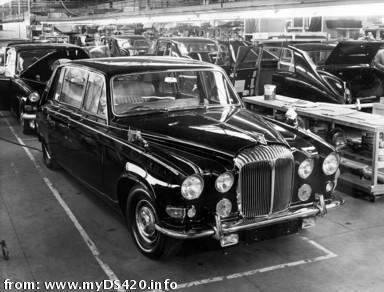 |
Every publication about the DS420 lists slightly different production/sales figures, but the most comprehensive list comes from the book "Jaguar, a living legend", by Anders D. Clausager. At the time of publication, Mr. Clausager was an archivist to the British Motor Heritage Trust. In the table below, the column Production is taken from Mr. Clausager's book. Since the book was published in 1990, it does not have figures for 1989-1992. They were deduced from various other sources. Left: very early cars at the VandenPlas works in Kingsbury (click to enlarge)The DS420 was well known for its extensive list of optional accessories, which could increment the basic price of the car by 50%. This web page, and its attached sub-pages, show price information and option lists for each individual year. Also of interest are the prices for the Chassis only car, to be sold to hearse building companies. |
|
The following table lists the basic price of the limousine, including taxes, in GB£ for the UK market. Some rows have two prices, if the given year had price increases (that I know of). The source of the information is given for every year where applicable. Where an entry says Show ... price list you can click through to a page showing the original price and option list (often multiple lists) for the given year. Every price list shows the available options, with their individual price figures. Please note that a given year may have had more price lists, and thus multiple price figures, than shown here. |
| Year | Prices | Price info source | Production | Cumulative | Year | ||||
|---|---|---|---|---|---|---|---|---|---|
| limo | chassis | limo | chassis | total | |||||
| 1968 | £ 4424.9.5 | £ 4520.16.5 | Show 1968 price lists | 18 | 6 | 18 | 6 | 24 | 1968 |
| 1969 | £ 4520.16.5 | £ 4874.12.6 | Show 1969 price lists | 291 | 33 | 309 | 39 | 348 | 1969 |
| 1970 | £ 4994.14.9 | £ 5445.3.1 | Show 1970 price lists | 428 | 61 | 737 | 100 | 837 | 1970 |
| 1971 | £ 5500.62 | Show 1971 price list | 236 | 50 | 973 | 150 | 1123 | 1971 | |
| 1972 | £ 5665.63 | £ 5922.40 | Show 1972 price lists | 244 | 43 | 1217 | 193 | 1410 | 1972 |
| 1973 | £ 5839.16 | £ 6401.64 | Show 1973 price lists | 263 | 31 | 1480 | 224 | 1704 | 1973 |
| 1974 | £ 6899.75 | £ 7643.61 | Show 1974 price lists | 243 | 46 | 1723 | 270 | 1993 | 1974 |
| 1975 | £ 8393.58 | £ 9210.24 | Show 1975 price lists | 235 | 64 | 1958 | 334 | 2292 | 1975 |
| 1976 | £ 9767.16 | £ 11451.96 | Show 1976 price lists | 145 | 40 | 2103 | 374 | 2477 | 1976 |
| 1977 | £ 12597.39 | £ 13572.- | Show 1977 price lists | 123 | 51 | 2226 | 425 | 2651 | 1977 |
| 1978 | £ 14929.20 | £ 17640.09 | Show 1978 price lists | 139 | 48 | 2365 | 473 | 2838 | 1978 |
| 1979 | £ 17640.09 | £ 23546.25 | Show 1979 price lists | 129 | 44 | 2494 | 517 | 3011 | 1979 |
| 1980 | £ 24723.56 | £ 25712.76 | Show 1980 price lists | 103 | 40 | 2597 | 557 | 3154 | 1980 |
| 1981 | £ 26998.46 | Show 1981 price lists | 169 | 22 | 2766 | 579 | 3345 | 1981 | |
| 1982 | £ 23588.60 | £ 24768.41 | Show 1982 price lists | 102 | 16 | 2868 | 595 | 3463 | 1982 |
| 1983 | £ 25994.31 | Show 1983 price lists | 146 | 22 | 3014 | 617 | 3631 | 1983 | |
| 1984 | £ 25994.31 | £ 27995.- | Show 1984 price lists | 145 | 24 | 3159 | 641 | 3800 | 1984 |
| 1985 | £ 27995.- | £ 29995.- | Show 1985 price lists | 170 | 44 | 3329 | 685 | 4014 | 1985 |
| 1986 | £ 31950.- | Show 1986 price lists | 132 | 43 | 3461 | 728 | 4189 | 1986 | |
| 1987 | £ 31950.- | £ 36400.- | Show 1987 price lists | 139 | 37 | 3600 | 765 | 4365 | 1987 |
| 1988 | - | none published | 121 | 33 | 3721 | 798 | 4519 | 1988 | |
| 1989 | £ 40000.- | Show 1989 price list | 161 | 33 | 3882 | 831 | 4713 | 1989 | |
| 1990 | £ 43000.- | Show 1990 price list | 141 | 28 | 4023 | 859 | 4882 | 1990 | |
| 1991 | £ 46500.- | £ 47520.- | Show 1991 price lists | 96 | 30 | 4119 | 889 | 5008 | 1991 |
| 1992 | £ 45692.32 | Wilcox Limousines | 22 | 14 | 4141 | 903 | 5044 | 1992 | |
| Year | Prices |
Show all price lists together |
limo | chassis | limo | chassis | total | Year | |
| Production | Cumulative | ||||||||
| Over the 25 year life span of the model, the price slowly climbed to a tenfold of the introduction price. This is equivalent to a sustained inflation rate of almost 10% every year. Note how the price doubled from 1973 to 1976 (four years), and again doubled from then to 1979 (three years). |
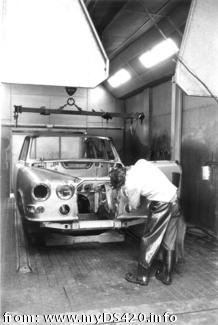
| ||
|
The 1992 price is taken from a set of hand written price quotations by Wilcox Limousines; they will be shown if you click on that table entry. Around 1981 the limousine was again hit by the soaring inflation, because of its labour intensive production. A magazine article (shown on the page with English language articles) touches upon this subject and talks about price cuts together with reorganisations to fight the rising costs. The resulting 12.5% price cut was massive. However, the sales volume before the price cut went up 50% already. |
Assembly at Vanden Plas in Kingsbury.
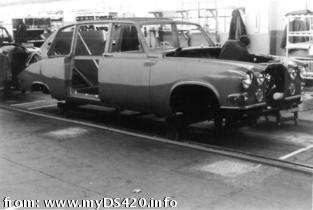
|
||
Below: 1985 body shells at Browns Lane (click to enlarge).
More photos taken at this location were published
in a 2008 magazine article.
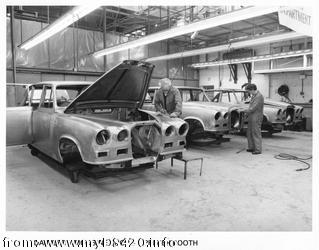
|
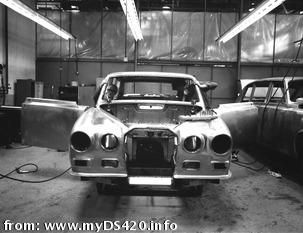
|
The best way to deduce the year of construction from the chassis number is with the PDF-file that is available on the web site of the Jaguar Daimler Heritage Trust. The following scheme roughly applies (see below for more details):
In 1979 the automobile industry adopted the international VIN number format, which had a 6-digit number field. Jaguar followed in March 1981. A detailed explanation of this VIN number format is on my webpage with various technical illustrations. | ||||||||||
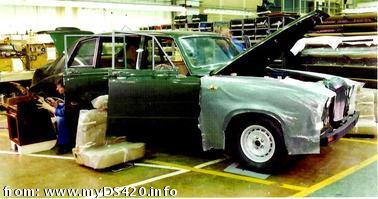
|
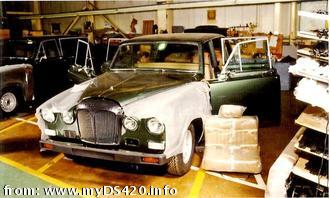
|
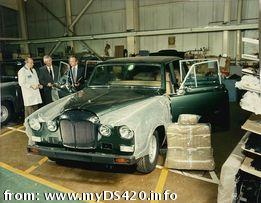 |
A very interesting series of nine photos was made in February 1981 by photographer Edward Eves in the Limousine Department at Jaguar's Browns Lane plant. They are now in the portfolio of the Revs Institute in Naples, Florida, U.S.A. and can not be shown here for copyright reasons. But they can be viewed on the website of the copyright holder, who erroneously describes them as "Daimler Jaguar at Park Ward". On their pages click on each photo to view a large, albeit watermarked version: photo 282456, photo 284200, photo 299467, photo 304478, photo 305400, photo 307577, photo 312058, photo 320131, and photo 322526.
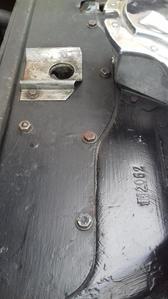
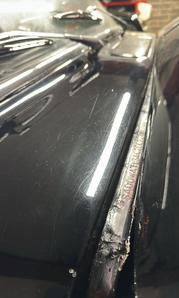 To find the Vehicle Identification Number
on the DS420 the bonnet must be opened.
An identification plaque is riveted in the engine bay,
for early cars on the right side wheel well,
later cars above the left side wheel well.
It shows car number (a.k.a. vehicle number, chassis number),
and body, engine and gearbox numbers.
Note that car number and body number are not the same
(body numbers all start with 4M).
But this plaque is damaged easily, and the rivets can be removed.
Therefore authorities often want to see a "stamped in" number.
Initially (1968-1970) the DS420 did not have this at all,
but starting somewhere around August 1970 - September 1970
the vehicle/car number was then stamped on the horizontal surface
above the radiator, where the bonnet catch/lock drops in (see photo).
The vehicle numbers on these early cars always have the format 1M
followed by a four-digit number (starting at 1001) for RHD cars,
or five digits (starting at 20001) for LHD.
From 1978 on, both the location and the format of the number changed.
Cars now got the number in front of the rightmost screen wiper:
lift the bonnet and look in the small 'trench'
where the upper edge of the bonnet drops in.
To find the Vehicle Identification Number
on the DS420 the bonnet must be opened.
An identification plaque is riveted in the engine bay,
for early cars on the right side wheel well,
later cars above the left side wheel well.
It shows car number (a.k.a. vehicle number, chassis number),
and body, engine and gearbox numbers.
Note that car number and body number are not the same
(body numbers all start with 4M).
But this plaque is damaged easily, and the rivets can be removed.
Therefore authorities often want to see a "stamped in" number.
Initially (1968-1970) the DS420 did not have this at all,
but starting somewhere around August 1970 - September 1970
the vehicle/car number was then stamped on the horizontal surface
above the radiator, where the bonnet catch/lock drops in (see photo).
The vehicle numbers on these early cars always have the format 1M
followed by a four-digit number (starting at 1001) for RHD cars,
or five digits (starting at 20001) for LHD.
From 1978 on, both the location and the format of the number changed.
Cars now got the number in front of the rightmost screen wiper:
lift the bonnet and look in the small 'trench'
where the upper edge of the bonnet drops in.
Examples of this would be: SADDWATL4AC200423 and SAJDWATL3AA201334.
Of the 4141 limousines 232 were LHD. There were no LHD chassis sales.
Only two USA-spec cars were manufactured.
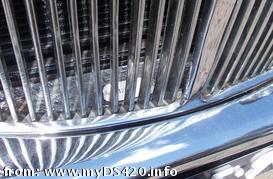 Until the end of 1979 the DS420 was assembled
at the VandenPlas works in Kingsbury, London.
Vanden Plas gave each car a Job Number
and the book Vanden Plas Coach Builders by Brian Smith
gives more details about these numbers.
They started at 12000 and eventually climbed up to around 14500.
This number is on a plate attached to the chassis
behind the bottom of the grille (facing forward).
It should not be confused with the chassis/VIN number.
Until the end of 1979 the DS420 was assembled
at the VandenPlas works in Kingsbury, London.
Vanden Plas gave each car a Job Number
and the book Vanden Plas Coach Builders by Brian Smith
gives more details about these numbers.
They started at 12000 and eventually climbed up to around 14500.
This number is on a plate attached to the chassis
behind the bottom of the grille (facing forward).
It should not be confused with the chassis/VIN number.
From the above table it can be deduced that the majority
of the DS420 production (3011/5044) has come from VandenPlas.
Over the total production period,
the average production was less than one car per day.
The Engine Number: apart from the identification plate in the engine bay (on the right wheel well for old version, left side above wheel well later), the engine numbers are also located (engraved) at a second location.
In August 1969 this location of the engine number changed; see this Service Bulletin B34 (August 1969). This was quite early in the life span of the DS420, so most cars have the number as described in this bulletin and shown on the photos below. Engine 7M1216 (mentioned in the bulletin) corresponds with car 1M1246, manufactured in September 1969. The nearest LHD car number is 1M20002 (also September 1969). However, the numbered engines were not used consecutively, and some higher numbered engines were already used from the preceding August on. Note that car numbers started at 1M1001, so there were approximately 250 earlier cars. The location of their engine number is explained in this Owners' Handbook (1017-1, pg, i07).
The following photos (lick to enlarge) all cover the "new" engine number location, which is on the head end of the flange which connects the engine to the gearbox., First we have an engine "in situ"; this photo is taken from the left side of the engine bay: engine with exhaust downpipes to the left, gearbox and firewall to the right. The engine oil dipstick and the exhaust downpipes are clearly visible, as is the vacuum unit that controls the water flow to the heater.
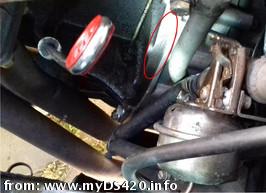
|
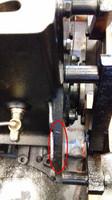
|

|
Unfortunately, the engine number is not easily distinguishable on that first photo. Therefore we have another photo, taken from an engine on an engine stand: engine block to the left, stand construction to the right. For clarity sake we even have a third photo with the number in isolation, cut-out from that previous photo. The number is visible as 7L12914-8. Since DS420 engine numbers all started with 7M, the 7L on this picture identifies the engine on the stand as a Sovereign 4.2 Litre one. But the location of the engine number is the same.
The numbers started in 1968 with 7M1001. In March 1983 the number was expanded from 4 positions to 6 by prefixing two zeroes. The last engine number issued (in 1992) was 7M006298-L. The -8 suffix on the Sovereign example above is the "old" format to identify a 1:8 compression ratio, which also was the standard value for DS420. This suffix changed in December 1970, as this Service Bulletin B54 explains. Almost all DS420 cars from then on got the -L version. No suffix present also means 'L'.
|
Right: Late eighties body shells being assembled at
Park Sheet Metal (click to enlarge) |
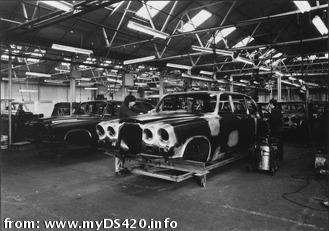 |
Some confusion is caused by the fact that the first edition of the Parts Catalogue (publ. No. JC53) states that chassis numbers for LHD vehicles start from 1M2001 onward; so a 0 digit is missing here. The next edition (publ.No. RTC9183A) corrects this mistake. Editions thereafter (publ. No. RTC9887CC and RTC9887CD) explicitly state "actual commencing date of manufacture 4.7.80" for numbers from 200038 (hearse 400041) on. Parts Catalogues give information about certain changes on the car, and often give both a RHD-number and a LHD-number where the change started. This suggests that these pairs can be used as rough synchronisation points between RHD and LHD numbers. Some of these pairs are: 1M1154/1M20003, 1M1663/1M20028, 1M1833/1M20034, 1M1938/1M20047, 1M1941/1M20046, 1M2181/1M20072, 1M2366/1M20082, 1M2408/1M20087, 1M2566/1M20093, 1M2662/1M20096, 1M2669/1M20099, 1M2744/1M20103, 1M2828/1M20110, 1M2951/1M20115, 1M3082/1M20120, 1M3217/1M20132, 1M3382/1M20139, 1M3455/1M20145, 1M3469/1M20147. But keep in mind that the car with the LHD-number may have been built quite long after the corresponding RHD-one. |
|
The very last batch of limos built (Oct/Nov. 1992) was for the Royal family, and (the very last one) for the Jaguar Daimler Heritage Trust. This is the JDHT car, L420YAC, VIN SAJDWATL3AA201631. You may notice that, although manufactured in 1992, this car has an "L" registration, which is from 1994. The 1996 Jaguar/Daimler calendar had an airbrush drawing of this car. |
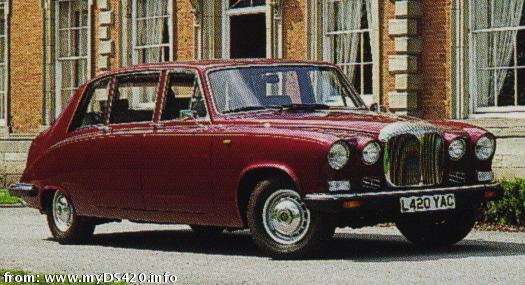
|